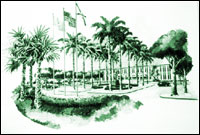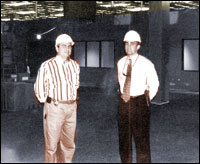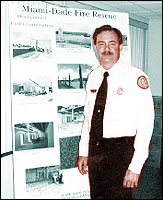|
 Doral
residents, for the most part, are aware that the Miami-Dade Fire
Rescue headquarters is moving to Doral, to the old Eastern/Oasis
building at 9600 NW 36 Street. Doral
residents, for the most part, are aware that the Miami-Dade Fire
Rescue headquarters is moving to Doral, to the old Eastern/Oasis
building at 9600 NW 36 Street.

An artist's rendering of the completed headquarters.
Few however, recognize the scope of the project, and
what a boon it will be not only to local businesses in Doral, but also
in terms of further strengthening the area's already formidable clout
and stature.

Miami-Dade Fire Rescue Division Manager Gianni Lehmann (left) and
Lieutenant Luis R. Fernandez, public relations manager for Miami-Dade
Fire Rescue and the Office of Emergency Management, examine the new
Miami-Dade Emergency
"95% of all the department's administrative work
will be done in this facility," explained Lieutenant Luis R.
Fernandez, public relations manager for Miami-Dade Fire Rescue and the
Office of Emergency Management (OEM). "This will be the largest
facility of its type in the southeastern United States, and the 11th
largest in the country."

Miami-Dade Fire Rescue Chief David
The new headquarters will house the Miami-Dade Fire
Rescue administrative staff, responsible for the 54 fire-rescue
stations in the county, as well as the Office of Emergency Management,
which is run by the department.
For Miami-Dade Fire Chief David Paulison, the project
is the culmination of years of work and the realization of a
twenty-year old dream.
"I worked for North Miami Beach before coming to
the county in 1978, and I was so embarrassed by the administration
building. I was just a firefighter at that point, but I made myself a
promise that if I ever got the opportunity, I would build the
department a headquarters they could be proud of."
To call the old headquarters an embarrassment is to be
kind. In fact, the previous Miami-Dade Fire-Rescue facility was the
old Dade County stockade and not only was it too small, it was a
hazardous place to work.
Paulison said, "The building we're currently in
is full of radon and asbestos, and the air conditioning was added on
and doesn't function well. It has been diagnosed with 'sick building
syndrome', which means it doesn't re-circulate air adequately, and in
order to fix that and the other problems, we'd have to evacuate it,
rent another site, and totally renovate it."
He continued, "By moving, it is actually less
expensive than renovating and renting until the work is complete, plus
it saves us more money down the road because we can consolidate all
our offices instead continuing to rent additional space to accommodate
our staff. And it's easier to have everyone all in one place, not just
for us, but the public also."
The new facility should be more than capable of
accommodating them both now and in the future. Its size is
mind-boggling: the gross square footage of the building is 144,00 and
the net is 128,000, with 23,000 of that going to emergency management.
While the OEM moved in during the first week of May,
full occupancy of the building isn't expected until the end of June or
the beginning of July.
The OEM's Emergency Operating Center (EOC) will be
amongst the best equipped in the world. The EOC becomes the county's
nerve center during natural disasters, and until recently resided in a
woefully inadequate facility. Given South Florida's propensity for
hurricanes, a top-notch EOC was a major priority.
There will be a huge main room, along with adjacent
conference rooms and a press room. The main room is equipped with 15
plasma monitors, which can display any type of data, and should there
be a power interruption at the facility, a large, secure generator
will be available to service the center.
Other changes to the building, already very solidly
built, will make it even more weatherproof. These include
state-of-the-art storm shutters and a total renovation of the
building's air conditioning and electrical systems.
Paulison also said that by moving the EOC into the
headquarters instead of building a facility of its own was a
cost-effective move.
Paulison explained, "The cost of moving the
center into the building was insignificant compared to constructing
one specifically for it, which would have cost in the neighborhood of
$15 million."
While there were some initial fears about increased traffic due to the
facility, Miami-Dade Fire Rescue Division Manager Gianni Lehmann, who
headed the project for the county, was quick to downplay those
concerns.
"Before you build or renovate," said Lehmann,
"a concurrency study must be done. There will be 350 employees at
the facility, but that is only a third of the amount that Eastern and
Oasis had here."
Miami-Dade is widely recognized to be one of the top
fire-rescue organizations in the world. They currently have a working
agreement with the Federal Emergency Management Agency (FEMA) and
United States Agency for International Development (USAID) to respond
to national and international disasters.
Fernandez said, "We're one of two teams
nationwide that responds on behalf of the United States government to
handle search and rescue as well as humanitarian coordination and
relief. And we've been doing it for some time now--since the 1985
earthquake in Mexico City."
The nice thing about that experience, Fernandez
continued, is that it can also be applied right here at home. All that
experience gained abroad has been extremely useful in dealing with
problems right here at home, whether it's a crash at the airport or
responding to a natural disaster like Hurricane Andrew.
The department also prides itself on its stance on
gender integration--Miami-Dade currently has 1560 firefighters, 275 of
which are women. That's more than any other department nationwide,
including the City of New York, which has 14,000 fire fighters, and
the 4,000 members of the City of Los Angeles Fire Department.
Paulison, Lehman, and Fernandez all agreed that both
the men and women of the fire-rescue department are excited about
moving to Doral.
Fernandez said, "We wanted to house our employees
safely, we wanted sufficient space, and we wanted to be community
friendly, those were our three priorities. All of them were met
here."
Lehmann said, "The physical characteristics of
the building as well as its historical implications (it was the former
Eastern Air Lines headquarters) made it perfect choice."
Paulison concluded, "We needed to be somewhere in
the center of the county, and Doral is such a great community. This
building was such a tremendous opportunity, we couldn't pass it up.
And we want to be partners with the community--we worked with Doral in
convincing the INS that Doral was an inappropriate site (the INS
building would've been just to the west of the new headquarters).
There are frequent demonstrations at facilities of that sort, and
though I fully support the right of citizens to protest, it's an
important part of our society, it just wouldn't be a good thing next
to our headquarters since they could possibly disrupt the EOC."
|